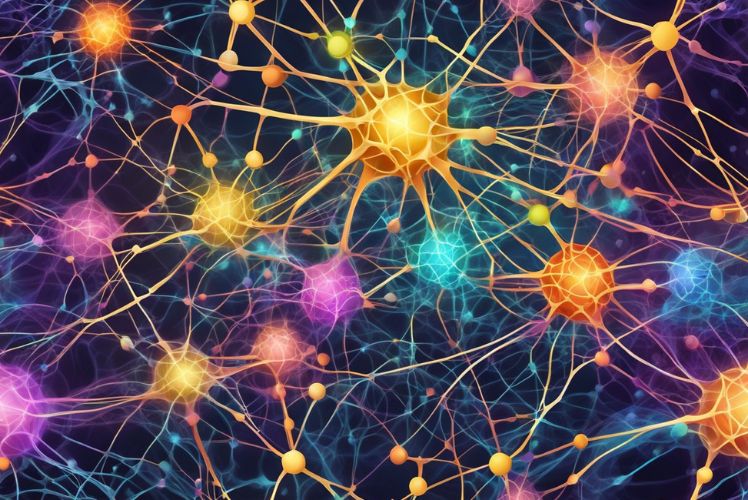Brain and neuroscience are vital fields that help us understand the complexities of the human brain and nervous system. These areas of study explore how our brains function, how they affect our behaviour, and how they interact with our bodies. Our knowledge of neuroscience is crucial not only for advancing medical science but also for improving mental health care and understanding human cognition.

As we delve into brain and neuroscience, we encounter various disciplines that contribute to our understanding of the mind. From molecular biology to cognitive psychology, each aspect offers insights that enrich our knowledge. The interplay between these fields enables us to better grasp how the brain operates and how it influences our everyday lives.
1) Studies in Molecular Neuroscience

Molecular neuroscience focuses on the molecular mechanisms that underlie brain function and behaviour. We study how specific molecules, such as neurotransmitters and hormones, influence neuronal activity.
Research in this field often employs techniques like electrophysiological recordings. These methods help us understand how neuronal circuits contribute to brain states and actions.
Recent advances include using stem cell-derived cerebral organoids. These organoids serve as models of human brain development, allowing us to investigate cellular processes that occur in early neurodevelopment.
Additionally, novel imaging tools enhance our ability to observe molecular interactions in real time. This technology has opened new avenues for exploring how molecules and cells interact during various brain functions.
By combining these approaches, we can uncover the complexities of brain health and disease. Molecular neuroscience is essential for translating research findings into therapies that may improve neurological health.
2) Cognitive Neuroscience Research

Cognitive neuroscience research focuses on how our brain supports mental processes. This field lies at the intersection of psychology and neuroscience, allowing us to study how brain activity relates to behaviours such as memory, perception, and language.
We can use various techniques, like neuroimaging, to observe brain function. These technologies help us understand how different areas of the brain contribute to specific cognitive tasks. Through this research, we gain insights into how experience shapes our brain and thinking.
Recent studies have shown the importance of both nature and nurture in cognitive development. Understanding these factors can advance our knowledge of mental health and conditions related to brain function.
We also investigate how cognitive processes can be disrupted in neurodegenerative disorders. This research is crucial for developing effective interventions and therapies for those affected. By studying the biological basis of cognition, we strive to uncover the complex relationship between brain health and mental processes.
Our ongoing work in cognitive neuroscience aims to deepen our understanding of the human mind and improve mental health outcomes.
3) Neurochemistry Advances

In recent years, we have seen significant progress in the field of neurochemistry. This area focuses on the chemicals in the brain and how they affect behaviour and functions. We can now measure neurochemical changes with greater accuracy.
New tools, like fluorescent protein-based probes, allow us to target specific neurons. These probes have high spatial and temporal resolution, making them useful for studying brain activity. We can study the brain in more detail than ever before.
The open-access journal Brain and Neuroscience Advances plays a key role in sharing this research. It encourages the exchange of ideas and findings in neurochemistry. By publishing new studies, the journal helps improve our understanding of brain function and its chemical processes.
As we continue to explore neurochemistry, we can uncover more about how these substances influence health and disease. This knowledge is vital for developing new treatments for neurological disorders. Advances in neurochemistry hold promise for future breakthroughs in neuroscience.
4) Explorations of Neurobiology

In our study of neurobiology, we focus on the cellular and molecular aspects of the nervous system. This field examines how these elements interact to affect brain function and behaviour.
We explore various components, such as neurons and glial cells. Understanding their roles helps us grasp how the brain processes information and responds to external stimuli.
Research often involves advanced techniques like imaging and genetic analysis. These methods allow us to observe brain activity and understand the underlying mechanisms of different neurological conditions.
Our knowledge in neurobiology also helps bridge gaps with broader neuroscience. Together, these fields enhance our understanding of the brain's complexity and its impact on human health.
As we continue our explorations, we uncover new insights that can lead to innovative treatments for neurodegenerative diseases. Our work contributes to a growing body of knowledge that benefits both science and society.
5) Investigations in Neurophysiology

In our exploration of neurophysiology, we focus on understanding how the brain and nervous system function. This field examines both the central and peripheral nervous systems, which are crucial for our overall health.
Advancements in technologies have enabled us to study brain activity in real-time. Methods like electroencephalography (EEG) help us measure electrical activity in the brain. We can connect these signals to cognitive processes.
Research in neurophysiology also involves single-cell profiling. Techniques like single-cell RNA sequencing allow us to understand cellular responses in the human brain. This can lead to better insights into various neurological conditions.
Furthermore, non-invasive brain stimulation techniques contribute to our understanding of brain functions. These methods can enhance cognitive abilities and help in rehabilitation efforts.
We are excited about the discoveries made through these investigations, as they enhance our knowledge of how the brain works and how we can address neurological issues.
6) Insights into Brain Disorders

We are gaining a deeper understanding of brain disorders through various research methods. For example, mini-brains are helping us to explore mitochondrial brain disorders more effectively. These models mimic human brain function and allow us to test different treatments in a controlled setting.
In another study, researchers developed a four-dimensional brain map. This map reveals early signs of multiple sclerosis before symptoms appear. This advancement may lead to better diagnosis and treatment options for patients.
We can also look at genomic insights into nutrition and brain disorders. Research shows that balanced expression of miRNAs is crucial for preventing neurodegeneration. Misregulation in these pathways can contribute to various age-dependent brain illnesses.
Furthermore, neuroimaging has made significant strides. It helps us understand the mechanics behind neurological and psychiatric disorders. As we continue our work, these insights are essential for improving treatments and outcomes for those affected.
7) Developments in Neural Networks

Recent advancements in neural networks have greatly influenced fields such as artificial intelligence and machine learning. These networks, inspired by the human brain, play a vital role in tasks like image recognition and natural language processing.
We see that neuroscience research is shaping how we develop these models. For example, studies show how the brain adjusts connections between neurons during learning. This knowledge could lead to improved algorithms in AI.
Additionally, understanding the differences between artificial neural networks (ANNs) and biological brain networks helps us refine our approaches. By learning how the brain processes information, we can create more efficient and capable neural networks.
As we explore these developments, the collaboration between neuroscience and AI continues to grow. This partnership may lead to systems that not only mimic human intelligence but also enhance our ability to understand complex data.
8) Advances in Neural Imaging

In recent years, we have seen significant progress in neural imaging techniques. These advancements allow us to study brain functions more clearly and in greater detail.
One notable development is in EEG technology. We now have better methods to analyse brain function and neural oscillations, which help us understand various brain activities.
Another important area is diffusion tensor imaging (DTI). This technique enhances our ability to analyse brain connectivity and white matter tracts, providing insights into conditions like schizophrenia.
Fluorescence imaging continues to be a vital tool. New techniques improve our ability to track chemical changes in the brain, allowing for a more precise view of neural interactions.
We also face challenges, such as reconciling the complexity of brain networks with the behaviour at the synapse level. This understanding will guide future research and therapeutic approaches, enhancing our overall comprehension of the brain and its functions.
As we combine these advances, we can expect to unlock more secrets of the brain, leading to better treatments for neurological disorders.
9) Progress in Neuropharmacology

We have seen significant advancements in the field of neuropharmacology, which studies how drugs affect the brain. This field combines aspects of neuroscience and pharmacology to improve our understanding of mental health conditions.
Research focuses on identifying brain structures involved in the psychological effects of drugs. This helps us develop new treatments for disorders like depression and anxiety. The work published in Progress in Neuro-Psychopharmacology and Biological Psychiatry highlights innovative approaches in both experimental and clinical settings.
Moreover, recent bibliometric studies have examined current trends and key topics in the field. These studies are essential for identifying hot areas of research and their impact on scientific discussions, as noted in When Neuroscience Meets Pharmacology.
As we push forward, the insights derived from neuropharmacology will play a critical role in shaping future therapeutic strategies for brain-related disorders.
10) Research in Neurogenesis

Research in neurogenesis focuses on how new neurons form in the brain. We know that this process mainly happens in certain areas, such as the hippocampus, even in adults. Some studies suggest that neurogenesis continues throughout life, while others indicate that it slows down with age.
Recent advancements in imaging techniques, like positron emission tomography, help us explore neurogenesis more effectively. These methods shed light on how the brain creates new neurons and how this may relate to learning and memory.
The topic remains controversial. While many agree that neurogenesis occurs in adults, the extent and significance are still debated. Researchers are examining different factors that influence neurogenesis, including stress, exercise, and diet.
Understanding neurogenesis can have implications for treating neurodegenerative diseases. We see potential for therapies that can stimulate neuron growth to improve brain health. This area of study continues to evolve, promising exciting developments for neuroscience.
Understanding Brain Functions

The brain is a complex organ that relies on precise communication between its cells. By examining neural connections and the role of neurotransmitters, we can gain insights into how our brains operate and influence behaviour and emotions.
Neural Communication
Neural communication is the process by which nerve cells, or neurons, communicate. Each neuron has a structure that allows it to send and receive signals. This process occurs through electrical impulses and chemical signals.
When a neuron receives a signal, it generates an electrical impulse called an action potential. This impulse travels along the axon to the synapse, the junction between neurons. At the synapse, the impulse triggers the release of neurotransmitters. These chemicals cross into the next neuron, continuing the signal.
This communication is essential for everything we do, from basic reflexes to complex thoughts. The efficiency of this communication can impact mental health and cognitive function, highlighting the significance of understanding how our brain works.
Role of Neurotransmitters
Neurotransmitters are crucial chemical messengers in the brain. They transmit signals between neurons, influencing mood, sleep, and cognitive functions. Some well-known neurotransmitters include:
- Dopamine: Associated with pleasure and reward.
- Serotonin: Regulates mood and anxiety.
- Acetylcholine: Important for memory and learning.
Each neurotransmitter has specific roles and can affect us in different ways. For example, an imbalance in dopamine can lead to disorders like Parkinson's disease. Understanding these chemicals allows us to grasp how our brain influences behaviour and emotions.
By studying neurotransmitters, we gain insight into potential treatments for various neurological disorders, helping us support brain health and improve mental well-being.
Advancements in Neuroscience Research

Neuroscience research has made remarkable strides in recent years. We are witnessing new techniques that improve our understanding of the brain and significant breakthroughs in addressing brain disorders.
Innovative Neuroimaging Techniques
Neuroimaging has evolved significantly, providing us with powerful tools to study the brain. Techniques like functional Magnetic Resonance Imaging (fMRI) and Positron Emission Tomography (PET) offer insights into brain activity and structure.
-
fMRI detects brain activity by measuring changes in blood flow. This helps us understand how different regions of the brain respond during various tasks.
-
PET scans allow us to visualise metabolic processes in the brain. They are crucial for diagnosing conditions like Alzheimer's disease.
These advances aid researchers in mapping brain networks, leading to improved diagnosis methods and targeted therapies.
Breakthroughs in Brain Disorders
Research into brain disorders has seen significant advancements, particularly in the areas of neurodegenerative diseases and mental health disorders. Ongoing studies are yielding promising results.
-
We have seen progress in treatments for Alzheimer's with new drugs showing potential in slowing disease progression.
-
In the realm of mental health, novel therapeutics, including ketamine and psychedelics, are being explored for their rapid antidepressant effects.
These breakthroughs offer hope for affected individuals and their families, potentially leading to more effective management strategies and improved quality of life.
Frequently Asked Questions

In this section, we explore key questions about brain structure and functions, the development of the brain in children, and the role of neuroscience in psychology. We will also look at important factors in neuroscience publications, the effects of thoughts on brain changes, and the different branches of neuroscience.
What are the principal parts and functions of the brain?
The brain is made up of several key parts. The cerebrum controls thinking and movement. The cerebellum helps with balance and coordination, while the brainstem regulates vital functions like breathing and heart rate. Each region works together to manage our thoughts, emotions, and bodily functions.
How does neuroscience explain the development of the brain in children?
Neuroscience shows that a child's brain develops rapidly during early years. Experiences and environments shape brain connections. Critical periods exist, where specific skills like language and motor functions are easier to learn. Understanding this helps us support healthy brain development in children.
What is the role of neuroscience within the field of psychology?
Neuroscience provides insights into how our brains influence behaviour and emotions. It helps psychologists understand mental processes and disorders. This connection aids in developing effective therapies and treatments to support mental health and well-being.
What impact factors are considered significant in neuroscience publications?
In neuroscience publications, factors like novelty, methodological rigor, and scientific impact are vital. Journals often assess how well research contributes to existing knowledge. The clarity of results and their implications for further study also play a key role in publication success.
How can an individual’s thoughts lead to changes within the brain?
Our thoughts can physically alter brain structure and function. Positive thinking may lead to improved mental health. Learning and practicing new skills create new neural pathways. This ability shows how adaptable our brains are through experiences and mental activities.
What are the different branches of neuroscience, and how do they differ?
Neuroscience has various branches, including molecular neuroscience, cognitive neuroscience, and neurophysiology. Molecular neuroscience focuses on cellular mechanisms, while cognitive neuroscience studies mental processes. Neurophysiology examines how systems operate within the brain. Each branch offers unique insights into how the brain functions.













